Semidiurnal Internal Tide Interference in the Northern South China Sea
Abstract
:1. Introduction
2. Data and Methods
2.1. In Situ Mooring Data
2.2. Altimeter Data
2.3. Modal Decompositon
2.4. Energy and Flux of Internal Tides
2.5. Directional Fourier Filter Method
2.6. Ray-Tracing Model
3. Observation Results and Analysis
3.1. Evidence of Interference Revealed by Mooring Observations and Its Temporal Variations
3.2. Interference Pattern Formed by Two Dominant Branches
3.3. Influence of an Anticyclonic Eddy on the Interference Variation
4. Discussion
5. Conclusions
Author Contributions
Funding
Institutional Review Board Statement
Informed Consent Statement
Data Availability Statement
Acknowledgments
Conflicts of Interest
References
- Zhao, Z. Internal tide radiation from the Luzon Strait. J. Geophys. Res. Oceans 2014, 119, 5434–5448. [Google Scholar] [CrossRef]
- Zhao, Z. The global mode-2 M2 internal tide. J. Geophys. Res. Oceans 2018, 123, 7725–7746. [Google Scholar] [CrossRef]
- Arbic, B.K. Incorporating tides and internal gravity waves within global ocean general circulation models: A review. Prog. Oceanogr. 2022, 206, 102824. [Google Scholar] [CrossRef]
- Egbert, G.D.; Ray, R.D. Estimates of M2 tidal energy dissipation from TOPEX/Poseidon altimeter data. J. Geophys. Res. Oceans 2001, 106, 22475–22502. [Google Scholar] [CrossRef]
- MacKinnon, J.A.; Zhao, Z.; Whalen, C.B.; Waterhouse, A.F.; Trossman, D.S.; Sun, O.M.; Laurent, L.S.; Simmons, H.L.; Polzin, K.; Pinkel, R.; et al. Climate process team on internal wave–driven ocean mixing. Bull. Am. Meteorol. Soc. 2017, 98, 2429–2454. [Google Scholar] [CrossRef]
- Jayne, S.R.; St. Laurent, L.C. Parameterizing tidal dissipation over rough topography. Geophys. Res. Lett. 2001, 28, 811–814. [Google Scholar] [CrossRef]
- Johnston, T.M.S.; Merrifield, M.A. Internal tide scattering at seamounts, ridges, and islands. J. Geophys. Res. Oceans 2003, 108, C6. [Google Scholar] [CrossRef]
- Wang, Y.; Legg, S. Enhanced Dissipation of Internal Tides in a Mesoscale Baroclinic Eddy. J. Phys. Oceanogr. 2023, 53, 2293–2316. [Google Scholar] [CrossRef]
- Floor, J.W.; Auclair, F.; Marsaleix, P. Energy transfers in internal tide generation, propagation and dissipation in the deep ocean. Ocean Model. 2011, 38, 22–40. [Google Scholar] [CrossRef]
- Xu, Z.; Liu, K.; Yin, B.; Zhao, Z.; Wang, Y.; Li, Q. Long-range propagation and associated variability of internal tides in the South China Sea. J. Geophys. Res. Oceans 2016, 121, 8268–8286. [Google Scholar] [CrossRef]
- De Lavergne, C.; Falahat, S.; Madec, G.; Roquet, F.; Nycander, J.; Vic, C. Toward global maps of internal tide energy sinks. Ocean Model. 2019, 137, 52–75. [Google Scholar] [CrossRef]
- Guo, Z.; Cao, A.; Wang, S. Influence of Remote Internal Tides on the Locally Generated Internal Tides upon the Continental Slope in the South China Sea. J. Mar. Sci. Eng. 2021, 9, 1268. [Google Scholar] [CrossRef]
- Zhang, P.; Xu, Z.; You, J.; Hao, Z.; Yin, B.; Hou, Y.; Robertson, R. Satellite observed multisource internal tide radiation and interference in the Banda Sea. J. Geophys. Res. Oceans 2023, 128, e2022JC019383. [Google Scholar] [CrossRef]
- Rayson, M.D.; Jones, N.L.; Ivey, G.N.; Gong, Y. A seasonal harmonic model for internal tide amplitude prediction. J. Geophys. Res. Oceans 2021, 126, e2021JC017570. [Google Scholar] [CrossRef]
- Buijsman, M.C.; Legg, S.; Klymak, J. Double-ridge internal tide interference and its effect on dissipation in Luzon Strait. J. Phys. Oceanogr. 2012, 42, 1337–1356. [Google Scholar] [CrossRef]
- Buijsman, M.C.; Klymak, J.M.; Legg, S.; Alford, M.H.; Farmer, D.; MacKinnon, J.A.; Nash, J.D.; Park, J.-H.; Pickering, A.; Simmons, H. Three-dimensional double-ridge internal tide resonance in Luzon Strait. J. Phys. Oceanogr. 2014, 44, 850–869. [Google Scholar] [CrossRef]
- Rainville, L.; Johnston, T.M.S.; Carter, G.S.; Merrifield, M.A.; Pinkel, R.; Worcester, P.F.; Dushaw, B.D. Interference pattern and propagation of the M2 internal tide south of the Hawaiian Ridge. J. Phys. Oceanogr. 2010, 40, 311–325. [Google Scholar] [CrossRef]
- Zhao, Z. The global mode-1 S2 internal tide. J. Geophys. Res. Oceans 2017, 122, 8794–8812. [Google Scholar] [CrossRef]
- Zhao, Z.; Alford, M.H.; Simmons, H.L.; Brazhnikov, D.; Pinkel, R. Satellite investigation of the M2 internal tide in the Tasman Sea. J. Phys. Oceanogr. 2018, 48, 687–703. [Google Scholar] [CrossRef]
- Zhao, Z. Southward internal tides in the northeastern South China Sea. J. Geophys. Res. Oceans 2020, 125, e2020JC016554. [Google Scholar] [CrossRef]
- Wang, Y.; Xu, Z.; Hibiya, T.; Yin, B.; Wang, F. Radiation path of diurnal internal tides in the Northwestern pacific controlled by refraction and interference. J. Geophys. Res. Oceans 2021, 126, e2020JC016972. [Google Scholar] [CrossRef]
- Wang, Y.; Xu, Z.; Yin, B.; Hou, Y.; Chang, H. Long-range radiation and interference pattern of multisource M2 internal tides in the Philippine Sea. J. Geophys. Res. Oceans 2018, 123, 5091–5112. [Google Scholar] [CrossRef]
- Wang, M.; Zhu, X.H.; Zheng, H.; Chen, J.; Liu, Z.J.; Ren, Q.; Liu, Y.; Nan, F.; Yu, F.; Li, Q. Direct evidence of standing internal tide west of the Luzon Strait observed by a large-scale observation array. J. Phys. Oceanogr. 2023, 53, 2263–2280. [Google Scholar] [CrossRef]
- Zhao, Z.; Alford, M.H.; Lien, R.C.; Gregg, M.C.; Carter, G.S. Internal tides and mixing in a submarine canyon with time-varying stratification. J. Phys. Oceanogr. 2012, 42, 2121–2142. [Google Scholar] [CrossRef]
- Martini, K.I.; Alford, M.H.; Nash, J.D.; Kunze, E.; Merrifield, M.A. Diagnosing a partly standing internal wave in Mamala Bay, Oahu. Geophys. Res. Lett. 2007, 34, 17. [Google Scholar] [CrossRef]
- Johnston TM, S.; Rudnick, D.L.; Kelly, S.M. Standing internal tides in the Tasman Sea observed by gliders. J. Phys. Oceanogr. 2015, 45, 2715–2737. [Google Scholar] [CrossRef]
- Alford, M.H.; Simmons, H.L.; Marques, O.B.; Girton, J.B. Internal tide attenuation in the North Pacific. Geophys. Res. Lett. 2019, 46, 8205–8213. [Google Scholar] [CrossRef]
- Zhao, Z.; Wang, J.; Menemenlis, D.; Fu, L.L.; Chen, S.; Qiu, B. Decomposition of the multimodal multidirectional M2 internal tide field. J. Atmos. Ocean. Technol. 2019, 36, 1157–1173. [Google Scholar] [CrossRef]
- Pan, H.; Li, B.; Xu, T.; Wei, Z. Subseasonal tidal variability in the Gulf of Tonkin observed by multi-satellite altimeters and tide gauges. Remote Sens. 2023, 15, 466. [Google Scholar] [CrossRef]
- Li, B.; Wei, Z.; Wang, Y.; Guo, X.; Xu, T.; Lv, X. Application of S_TIDE in exploration of seasonal variations of internal tidal amplitudes in the northern South China Sea. J. Atmos. Ocean. Technol. 2021, 38, 1425–1438. [Google Scholar] [CrossRef]
- Cao, A.; Guo, Z.; Lv, X.; Song, J.; Zhang, J. Coherent and incoherent features, seasonal behaviors and spatial variations of internal tides in the northern South China Sea. J. Mar. Sci. Eng. 2017, 172, 75–83. [Google Scholar] [CrossRef]
- Guo, Z.; Cao, A.; Lü, X. Seasonal variation and modal content of internal tides in the northern South China Sea. J. Oceanol. Limnol. 2018, 36, 651–662. [Google Scholar] [CrossRef]
- Xu, Z.; Yin, B.; Hou, Y.; Xu, Y. Variability of internal tides and near-inertial waves on the continental slope of the northwestern South China Sea. J. Geophys. Res. Oceans 2013, 118, 197–211. [Google Scholar] [CrossRef]
- Li, B.; Wei, Z.; Wang, X.; Fu, Y.; Fu, Q.; Li, J.; Lv, X. Variability of coherent and incoherent features of internal tides in the north South China Sea. Sci. Rep. 2020, 10, 12904. [Google Scholar] [CrossRef] [PubMed]
- Wang, Z.; Huang, X.; Yang, Y.; Zhang, Z.; Zhou, C.; Zhao, W.; Tian, J. Impacts of subtidal motions and the earth rotation on modal characteristics of the semidiurnal internal tide. J. Oceanogr. 2020, 76, 15–27. [Google Scholar] [CrossRef]
- Huang, X.; Wang, Z.; Zhang, Z.; Yang, Y.; Zhou, C.; Yang, Q.; Zhao, W.; Tian, J. Role of mesoscale eddies in modulating the semidiurnal internal tide: Observation results in the northern South China Sea. J. Phys. Oceanogr. 2018, 48, 1749–1770. [Google Scholar] [CrossRef]
- Miao, M.; Zhang, Z.; Qiu, B.; Liu, Z.; Zhang, X.; Zhou, C.; Guan, S.; Huang, X.; Zhao, W.; Tian, J. On contributions of multiscale dynamic processes to the steric height in the northeastern South China Sea as revealed by moored observations. Geophys. Res. Lett. 2021, 48, e2021GL093829. [Google Scholar] [CrossRef]
- Zhang, Z.; Zhao, W.; Tian, J.; Liang, X. A mesoscale eddy pair southwest of Taiwan and its influence on deep circulation. J. Geophys. Res. Oceans 2013, 118, 6479–6494. [Google Scholar] [CrossRef]
- Duda, T.F.; Lin, Y.T.; Buijsman, M.; Newhall, A.E. Internal tidal modal ray refraction and energy ducting in baroclinic Gulf Stream currents. J. Phys. Oceanogr. 2018, 48, 1969–1993. [Google Scholar] [CrossRef]
- Zhao, Z.; Alford, M.H.; MacKinnon, J.A.; Pinkel, R. Long-range propagation of the semidiurnal internal tide from the Hawaiian Ridge. J. Phys. Oceanogr. 2010, 40, 713–736. [Google Scholar] [CrossRef]
- Alford, M.H.; Zhao, Z. Global patterns of low-mode internal-wave propagation. Part II: Group speed. J. Phys. Oceanogr. 2007, 37, 1849–1858. [Google Scholar] [CrossRef]
- Gong, Y.; Rayson, M.D.; Jones, N.L.; Ivey, G.N. Directional decomposition of internal tides propagating from multiple generation sites. Ocean Model. 2021, 162, 101801. [Google Scholar] [CrossRef]
- Gong, Y.; Xie, J.; Xu, J.; Chen, Z.; He, Y.; Cai, S. A directional decomposition method to estimate the reflection and transmission of nonlinear internal waves over a slope. J. Geophys. Res. Oceans 2022, 127, e2022JC018598. [Google Scholar] [CrossRef]
- Ubelmann, C.; Carrere, L.; Durand, C.; Dibarboure, G.; Faugère, Y.; Ballarotta, M.; Briol, F.; Lyard, F. Simultaneous estimation of ocean mesoscale and coherent internal tide sea surface height signatures from the global altimetry record. Ocean Sci. Discuss. 2021, 2021, 1–19. [Google Scholar] [CrossRef]
- Guo, Z.; Wang, S.; Cao, A.; Xie, J.; Song, J.; Guo, X. Refraction of the M2 internal tides by mesoscale eddies in the South China Sea. Deep. Sea Res. Part I Oceanogr. Res. Pap. 2023, 192, 103946. [Google Scholar] [CrossRef]

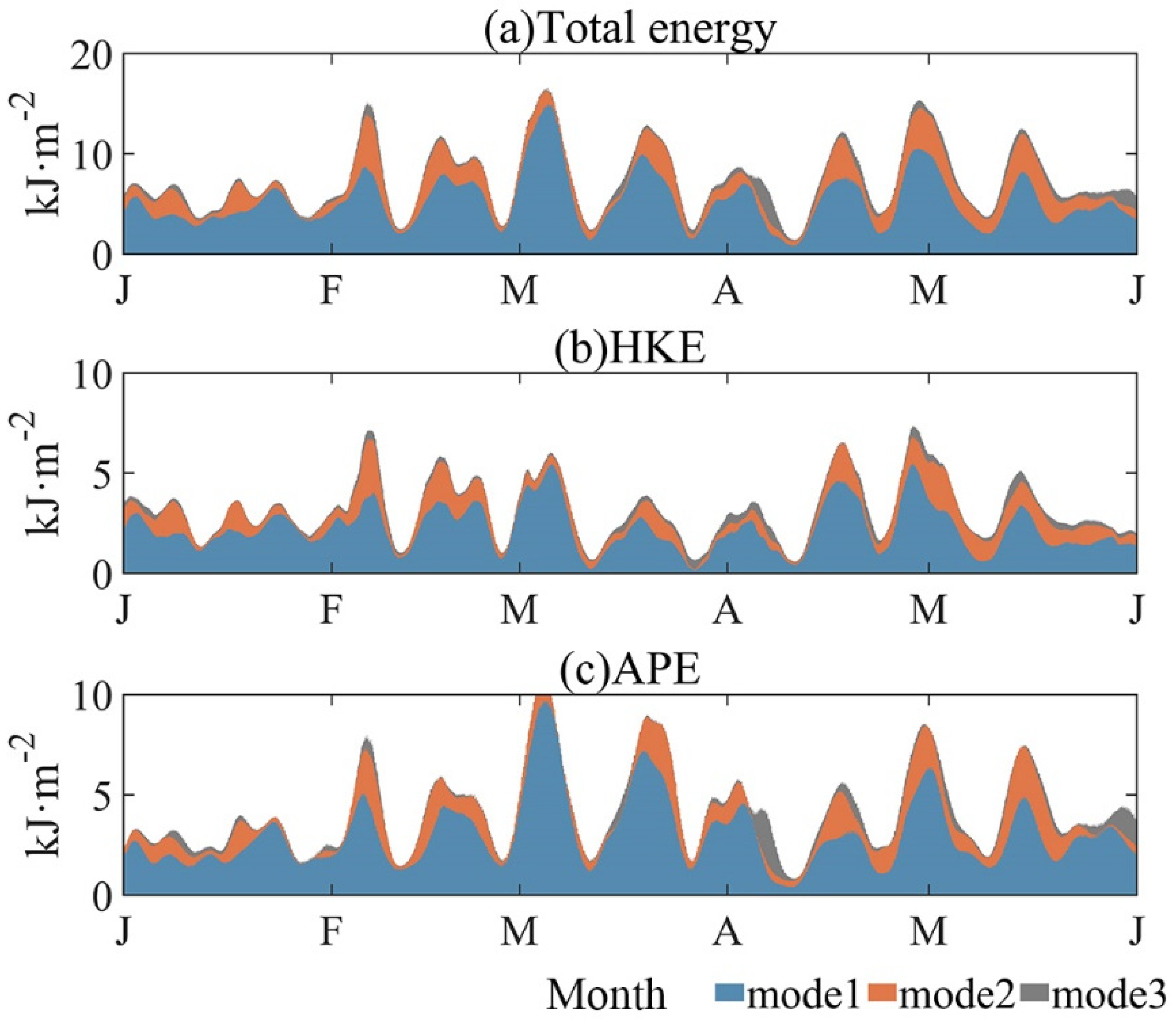
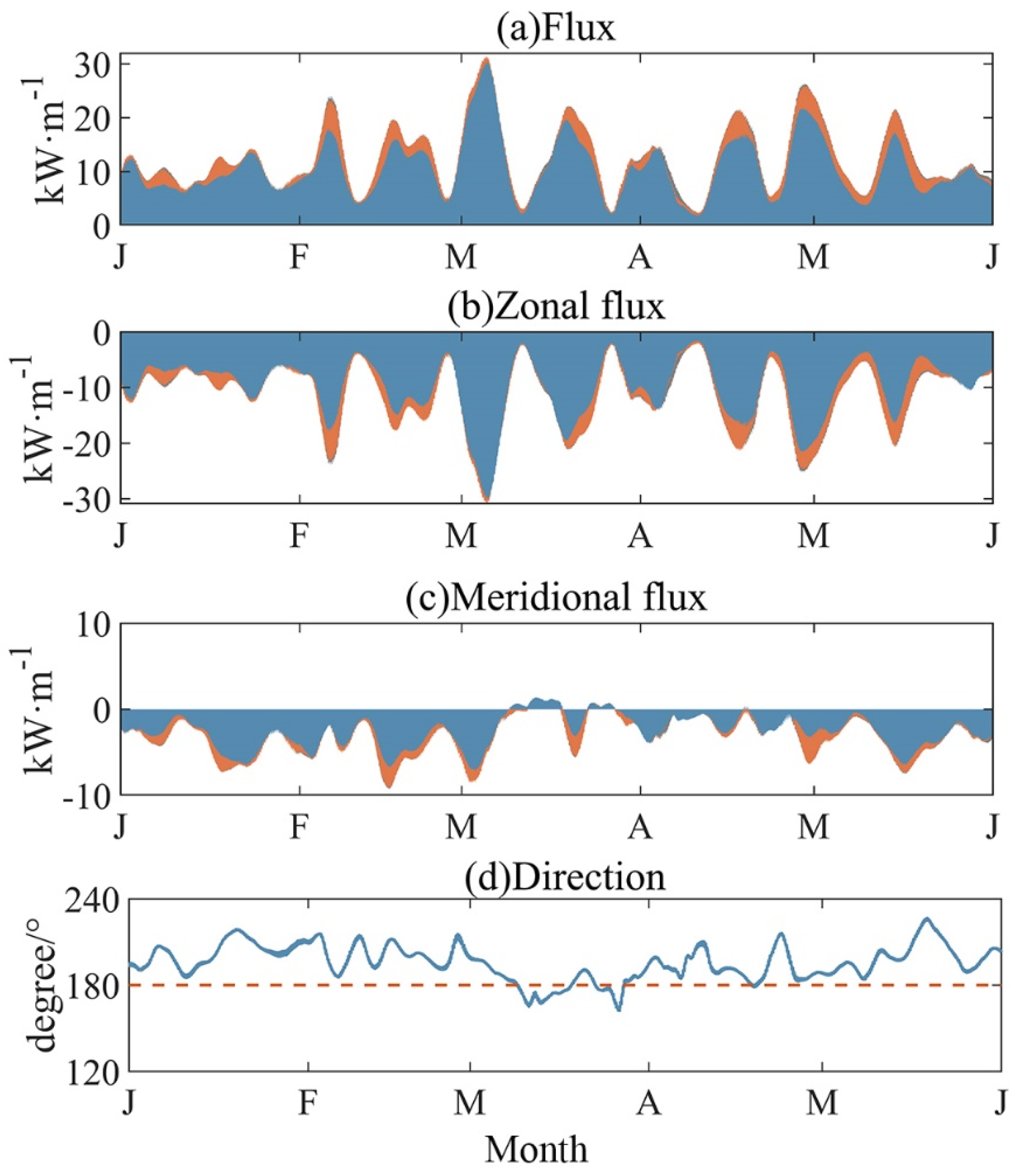

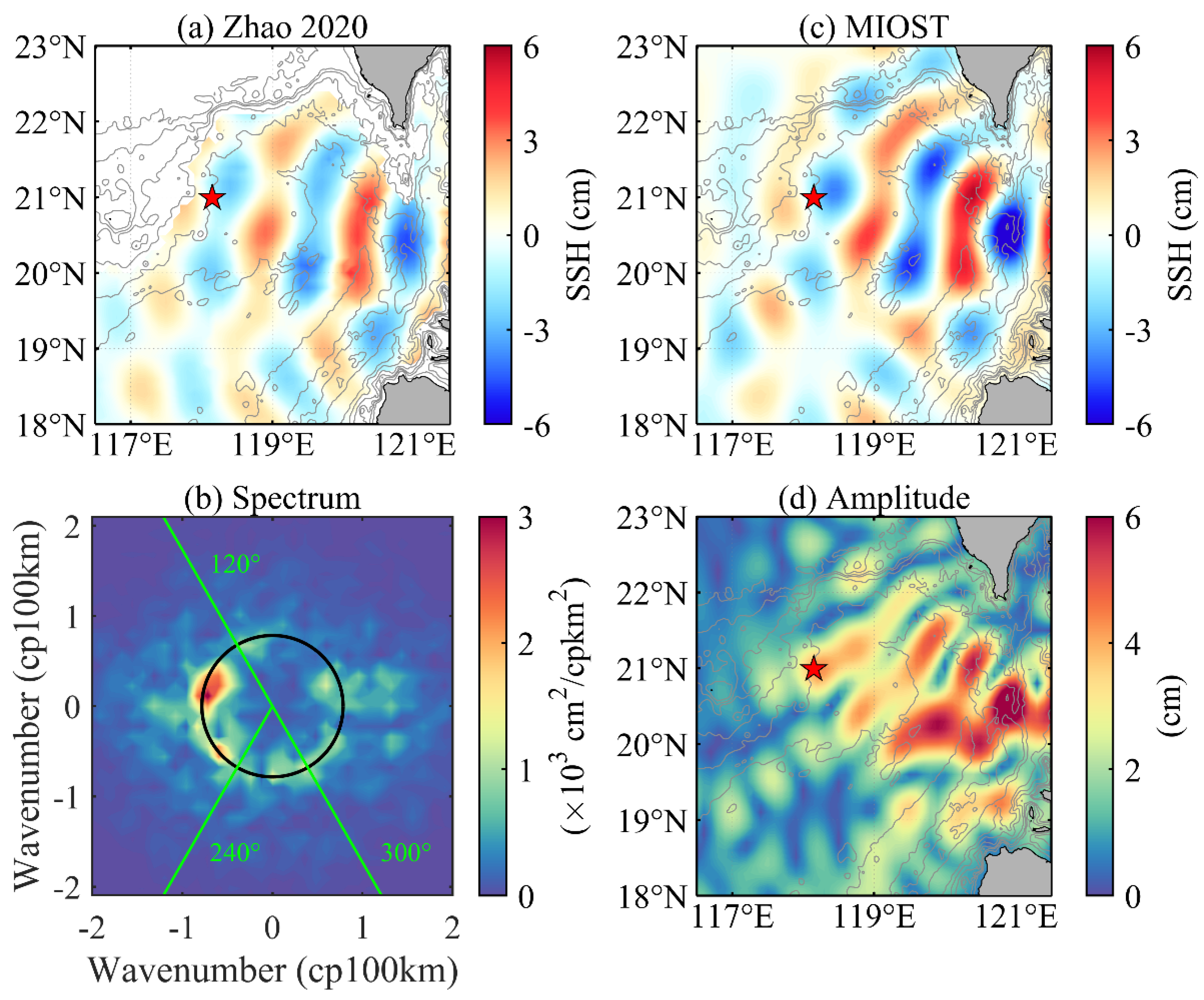
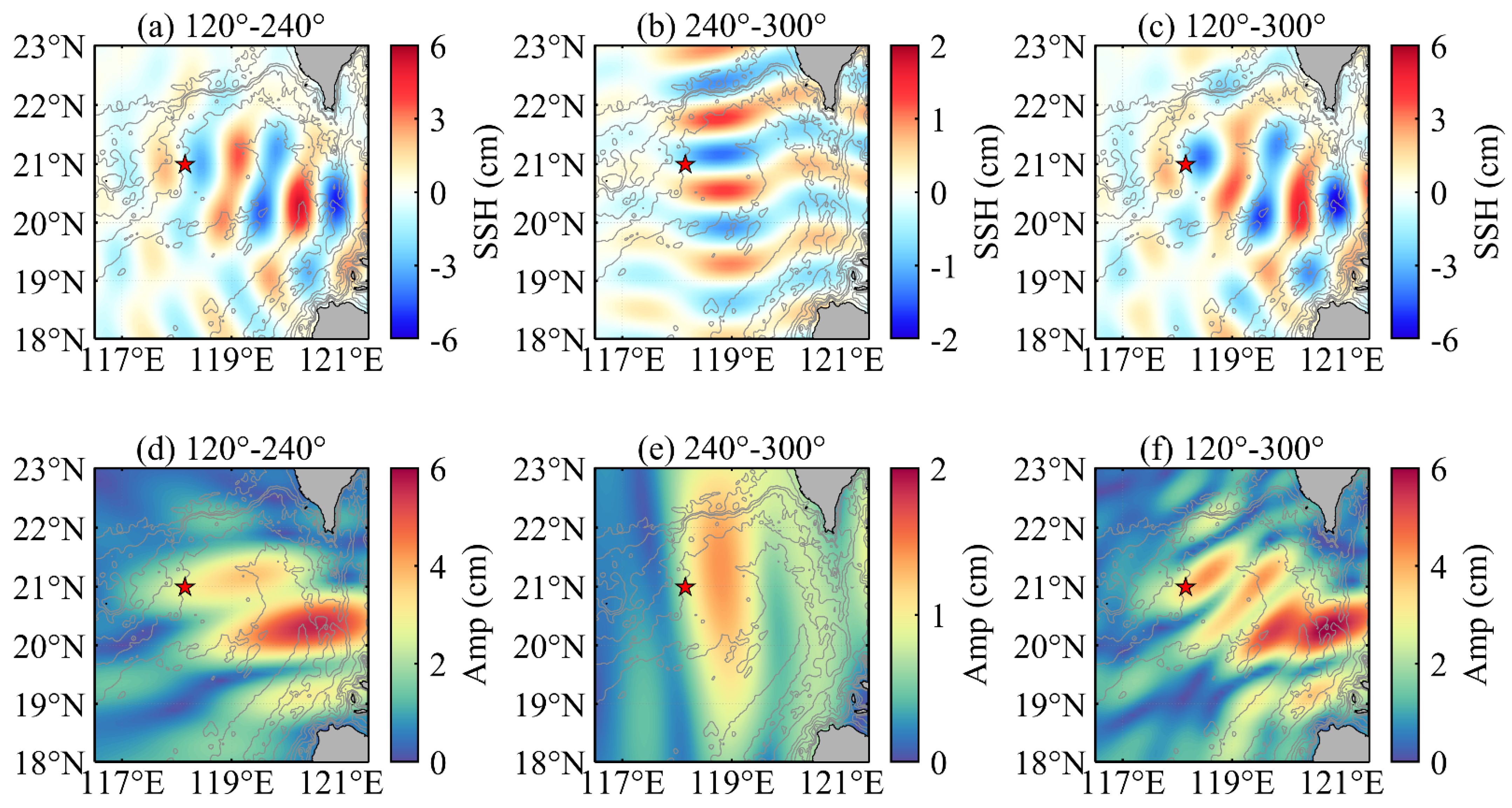
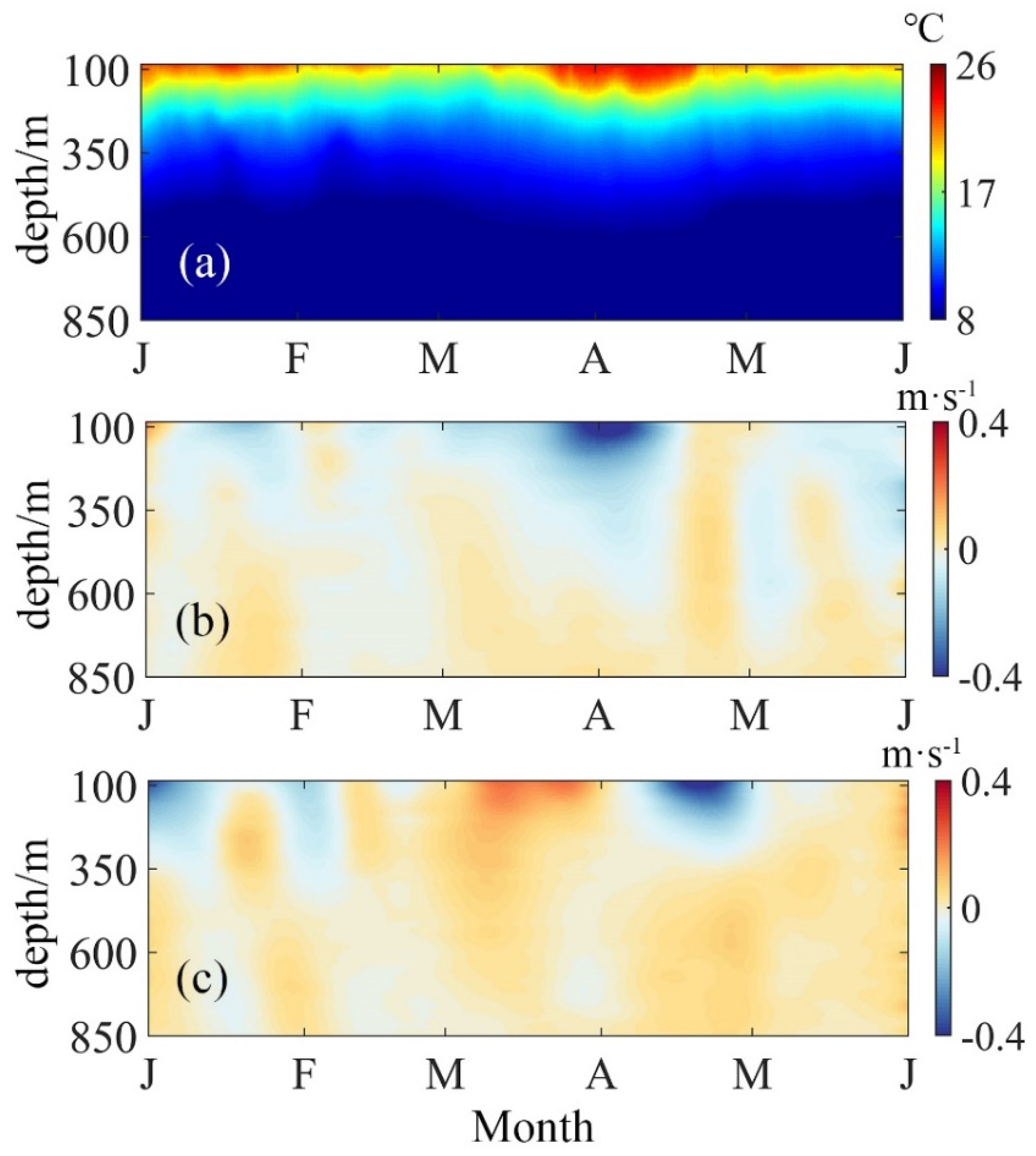
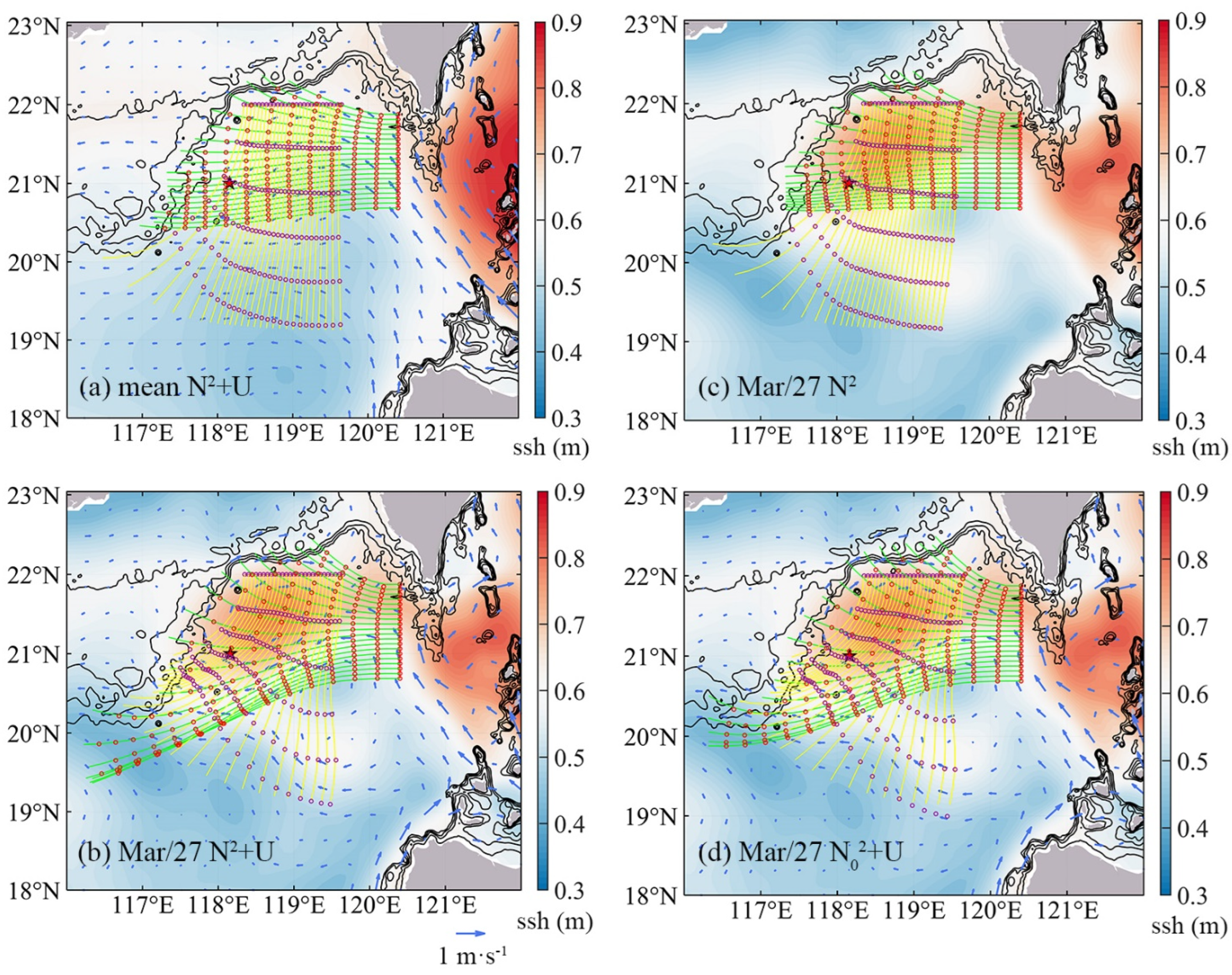
| Mooring Instrument | Instrument Depth (m) | Range Depth (m) | Sample Interval (min) |
|---|---|---|---|
| 75-kHz ADCP (up) | 492 | 50-462 | 3 |
| 75-kHz ADCP (dn) | 492, 996 | 522–972, 996–1476 | 3 |
| 300-kHz ADCP (dn) | 1900 | 1930–2020 | 3 |
| CTD | 87, 287, 497, 1001, 1705, 1905 | * | 2 |
| T/S chains | ** | 65–465, 465–665, 665–965 | 3 |
| RCM | 1700 | ** | 30 |
Disclaimer/Publisher’s Note: The statements, opinions and data contained in all publications are solely those of the individual author(s) and contributor(s) and not of MDPI and/or the editor(s). MDPI and/or the editor(s) disclaim responsibility for any injury to people or property resulting from any ideas, methods, instructions or products referred to in the content. |
© 2024 by the authors. Licensee MDPI, Basel, Switzerland. This article is an open access article distributed under the terms and conditions of the Creative Commons Attribution (CC BY) license (https://creativecommons.org/licenses/by/4.0/).
Share and Cite
Wang, W.; Li, J.; Huang, X. Semidiurnal Internal Tide Interference in the Northern South China Sea. J. Mar. Sci. Eng. 2024, 12, 811. https://doi.org/10.3390/jmse12050811
Wang W, Li J, Huang X. Semidiurnal Internal Tide Interference in the Northern South China Sea. Journal of Marine Science and Engineering. 2024; 12(5):811. https://doi.org/10.3390/jmse12050811
Chicago/Turabian StyleWang, Wenhui, Jiahui Li, and Xiaodong Huang. 2024. "Semidiurnal Internal Tide Interference in the Northern South China Sea" Journal of Marine Science and Engineering 12, no. 5: 811. https://doi.org/10.3390/jmse12050811
APA StyleWang, W., Li, J., & Huang, X. (2024). Semidiurnal Internal Tide Interference in the Northern South China Sea. Journal of Marine Science and Engineering, 12(5), 811. https://doi.org/10.3390/jmse12050811







